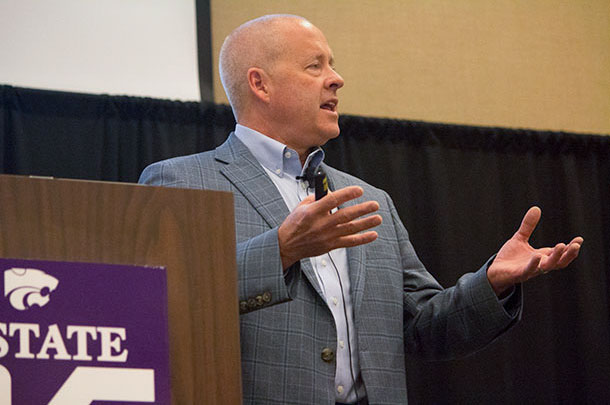The yearling bulls that will be sold in 2018 and used until 2022 or 2023 are gearing up for their first breeding season; their last calves won’t be born until 2023 or 2024; and their 10-year-old daughters won’t sell until about 2033 or 2034.
Unlike the pork and poultry industry, producers in the beef business have to have a long-term thought process about genetics and the effects it will have on the industry – because essentially “what’s done is done.”
At the annual Beef Improvement Federation (BIF) in Manhattan, Kansas, in June, several speakers touched on positioning the U.S. beef industry for success over the next 20 years. In particular, the cow-calf segment was challenged to minimize costs rather than increase production, and to improve reproductive efficiency and production at weaning.
Lower the cost of production
Dave Lalman, a beef cattle specialist at Oklahoma State University, discussed analyses, which compared profitability between 79 operations between 2010 and 2014. Through these data sets, it was found that the high-profit one-third averaged $415 more net return per cow compared with the low-profit one-third.
Lalman explained that when comparing high profitability to low profitability in these operations, 32.2 percent of the difference was due to gross income per cow and 67.8 percent of the difference was due to reduced expenses.
One opportunity Lalman gave to reduce expenses, specific to Oklahoma, is the amount of hay used in the cow-calf enterprise. He said the amount of hay used is increasing at a rate of about 66 pounds of more hay per year. If that trend continues into 2036, it will be up to about 3.2 tons of hay used per cow per year – and that’s in a state with a pretty long growing season.
“Just like we saw 20 years ago, some people in the industry are really good at being profitable and some people are not so much,” Lalman said. “I believe controlling cost in a cow-calf segment is more important than creating more production or more revenue – meaning more weaning weight, weaning rate, higher calf prices and so on.”

Mark Enns, a beef geneticist at Colorado State University, also pointed out that if producers were to improve the feed consumption in the cow herd or the “maintenance” of the animal, they would likely improve the profitability of beef production.
Cow feed intake, Enns said, is an economic relevant trait – a trait that if producers can apply selection pressure to, they can make improvements in the profitability of their production. He explained that the tools available to make improvements in maintenance requirements are based on mature weight and height, body condition scores and maintenance energy and $EN.
“Those are really – across our industry – the key components we have for changing cow maintenance requirements or the key traits that we measure,” Enns said. “The finished weight of steers in 2030 – if we keep on the current trajectory – is going to be over 1,560 pounds, and if we take our current trend of mature weight, we are going to have big cows in 20 years. We are not going to make much progress in reducing our input costs relative to maintenance requirements. So, that’s something to think about.”
Reproduction and weaning
Referring to the same data set, Lalman also noted room for improvement in weaning rates – the percentage of calves weaned per cow exposed – specifically in the South. He explained that there are exceptional weaning rates in the North at about 88 percent, while in the South, they are at an 83 percent weaning rate. Calf death loss could also be improved in the North, he said.
Many factors may contribute to the reduced weaning rate in the South, such as heat stress, parasite burden, lower forage quality, an increase in proportion of non-adapted cattle (dark hide and hair color in particular) and reduced utilization of Bos indicus cattle in planned crossbreeding systems.
As for weaning weight, Lalman said it doesn’t look like weaning weights have increased over the last 24 years, despite aggressive selection for growth. He speculates that it may have something to do with the environment of a commercial cow-calf operation that “generally speaking” has lower inputs.
“First of all, I think we must be clear that this research does not mean EPDs don’t work. It doesn’t even insinuate that EPDs don’t work,” said Jared Decker, a geneticist at Missouri State University in a blog post. “What it may mean is that the environment may be limiting the expression of an animal’s full genetic potential. If that is true, emphasis on selecting for increased weaning weight should be decreased, and selection pressure redirected to different traits.”
Based on surveys of commercial cattle producers, Decker is highly suspicious that the majority of producers are using EPDs at all, and if they are using them, the question is if they are using them appropriately.
There is a lot of room for improvement as commercial producers position themselves for the next 20 years. However, past experiences have shown the commercial sector is very receptive of calls for improvement, as they have worked to produce calves with tremendous capacity for post-weaning growth and carcass weights, improve docility and udder quality and structure, increase capacity for marbling, and reduce the incidence of dystocia. ![]()

-
Cassidy Woolsey
- Editor
- Progressive Cattleman
- Email Cassidy Woolsey
PHOTO 1: Dave Lalman presents on ways commercial producers can improve in the next 20 years at the Beef Improvement Federation (BIF) in Manhattan, Kansas.
PHOTO 2: Mark Enns addresses opportunities in understanding cow maintenance efficiency and maintenance requirements for improved profitability. Photos by Cassidy Woolsey.







